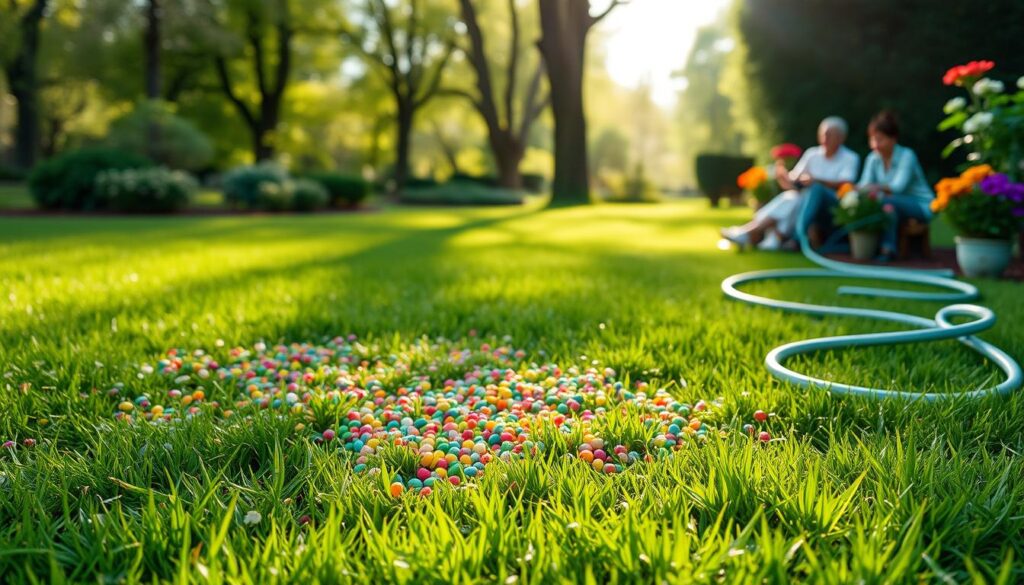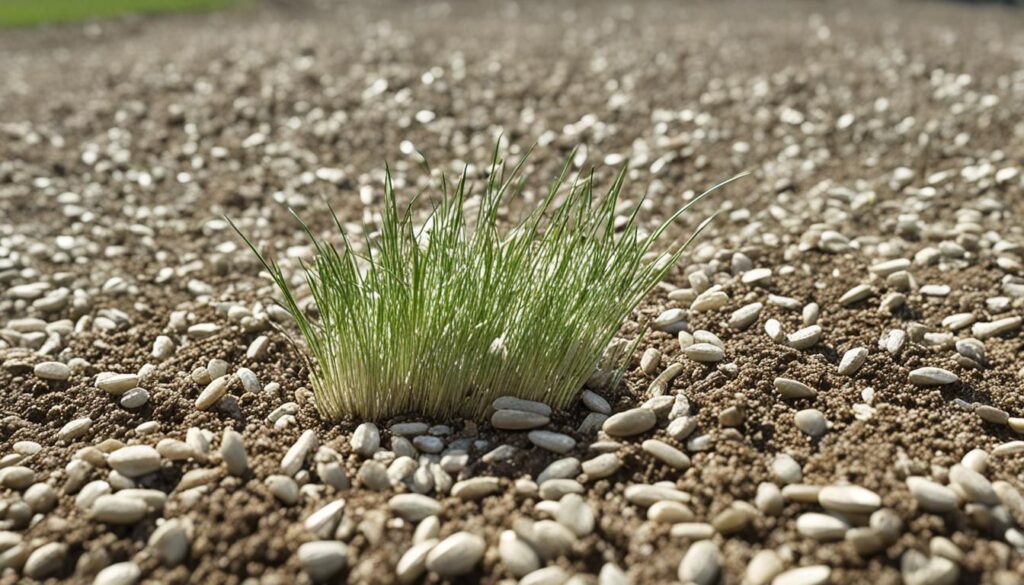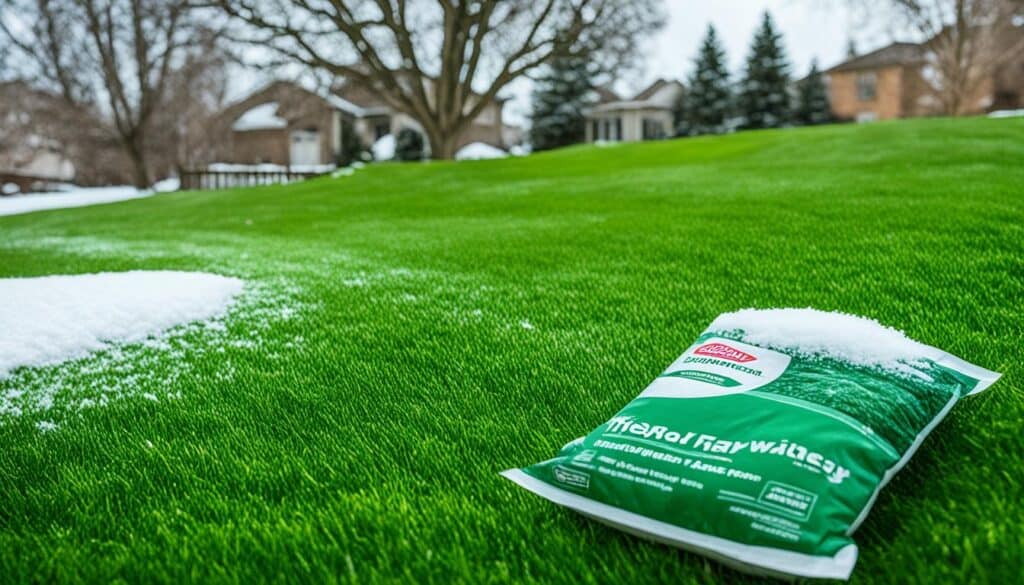Did you know the average American lawn needs four or more fertilizers a year? Spring is the best time to make your lawn healthy and green. The right spring fertilizer gives your grass the nutrients it needs after winter.
Key Takeaways
- Spring is a crucial time to fertilize your lawn and provide essential nutrients for growth.
- Choosing the right spring fertilizer can help your grass establish deep roots, resist heat and drought, and prevent weeds.
- Understanding the unique needs of your grass type and region can guide you to the best spring fertilizer option.
- Proper timing and application of spring fertilizer are key to achieving a lush, healthy lawn.
- Combining spring fertilization with other lawn care practices like aeration and drainage can maximize the benefits.
In this article, we’ll look at the top spring fertilizers for Northern and Southern lawns. We’ll help you pick the best one to make your grass green and vibrant all season.
Introduction: The Importance of Spring Lawn Fertilization
When winter ends and spring arrives, it’s time to think about spring lawn fertilization. Harsh winters can weaken your grass, making it more susceptible to diseases and pests. A weak lawn can’t fight off weeds, so it’s key to give it a strong start.
By choosing spring lawn care through fertilization, you get many benefits. It helps your lawn grow strong roots and stay healthy. This makes your lawn more resilient and less likely to need expensive treatments.
The importance of fertilizing lawn in spring is huge. It’s a vital step to keep your lawn looking great all year. It makes your outdoor space beautiful, weed-free, and safe for your family.
“A well-fertilized lawn is the foundation for a lush, vibrant, and healthy outdoor space.”
Learning about spring lawn fertilization and using the right methods can make your lawn thrive. You’ll enjoy a beautiful, easy-to-care-for outdoor space all season.
When to Fertilize Your Lawn in Spring
The best time to start spring lawn fertilization is when the soil hits 55°F consistently. This is usually around mid-April in most of the U.S. But, timing can change based on where you live and your grass type. Make sure the ground is thawed and look for new growth signs like taller grass or blooming flowers before fertilizing.
Ideal Soil Temperature and Signs of New Growth
Soil temperature is key to figuring out when to fertilize your lawn in spring. Aim for 55°F, which means your grass is starting to grow. Also, watch for these signs that your lawn is ready for spring fertilization:
- Grass blades are starting to grow taller and greener
- Flowering plants and shrubs are beginning to blossom
- The soil is no longer frozen and has a moist, workable texture
By fertilizing at the right time, your lawn gets the nutrients it needs to do well in spring and summer.
| Fertilization Timing | Application Window |
|---|---|
| Early Spring | February – April |
| Late Spring | April – June |
| Summer | June – August |
| Fall | August – November |
Using a lawn care program like Scotts® Turf Builder® Annual Program can make timing easier. These plans give you the right fertilizers at the best times for your grass and area.
Soil Testing: The Key to Choosing the Right Fertilizer
To get a lush, healthy lawn, start with a soil test. It helps you know what nutrients your lawn needs. This way, you can pick the right lawn fertilizer to fix any issues.
The best soil pH for grass is between 6 and 7, which is neutral. If your soil is too acidic or alkaline, you’ll need to adjust it first. Then, you can apply fertilizer.
Lawn fertilizers have three main nutrients: nitrogen (N), phosphorus (P), and potassium (K). The NPK ratio on the label shows how much of each is in the fertilizer. Nitrogen makes grass green and healthy, phosphorus helps roots grow, and potassium boosts overall health and fights diseases.
| Nutrient | Function |
|---|---|
| Nitrogen (N) | Promotes leafy growth and green color |
| Phosphorus (P) | Aids in root development |
| Potassium (K) | Encourages overall growth and health |
Soil testing helps you find the right fertilizer for your lawn. This ensures your grass gets the nutrients it needs for growth and health. Paying attention to these details can greatly improve your lawn’s look.
Granular vs. Liquid Lawn Fertilizers
Choosing between granular and liquid lawn fertilizers is key for lawn care. Each type has its own advantages and disadvantages. Knowing these can help you pick the right one for your lawn.
Granular fertilizers are simple to store and spread. They release nutrients slowly, lasting 4-6 weeks. This slow release supports your lawn’s health over time. But, it may take a week to see the effects.
Liquid fertilizers work faster, showing results in just 3 days. They apply evenly and are very effective. But, they need careful application and have a shorter shelf life.
| Feature | Granular Fertilizer | Liquid Fertilizer |
|---|---|---|
| Nutrient Release | Slow-release, over 4-6 weeks | Quick-release, visible in 3 days |
| Application | Easy to store and distribute | Requires precision, more uniform |
| Shelf Life | Longer shelf life | Shorter shelf life |
| Cost | Typically less expensive, especially in bulk | More expensive |
The choice between granular vs. liquid lawn fertilizer depends on your lawn’s needs and your preferences. Granular fertilizers are good for long-term health. Liquid fertilizers give quick, noticeable results. Think about your lawn’s needs and your budget to choose the best fertilizer for spring.
which fertilizer is best for grass in spring
Choosing the right fertilizer is key to a healthy lawn in spring. Your soil test will tell you what your grass needs. But, some fertilizers stand out for their ability to boost growth.
Stress 12-0-24 from Lebanon Turf and Humic Max 16-0-8 from Country Club are top picks. They have the right mix of nutrients for spring growth. Complete 14-7-14 from Lebanon Turf is another excellent option.
Look for a fertilizer rich in nitrogen for green leaves. Phosphorus and potassium help with roots and overall health. The right best fertilizer for grass in spring will keep your lawn looking great all season.
| Fertilizer | NPK Ratio | Key Features |
|---|---|---|
| Stress 12-0-24 | 12-0-24 | High in nitrogen and potassium to reduce stress and promote growth |
| Humic Max 16-0-8 | 16-0-8 | Contains humic acids to improve soil health and nutrient uptake |
| Complete 14-7-14 | 14-7-14 | Balanced formula for overall lawn health and vigor |
Follow the spring lawn fertilizer recommendations for your lawn and climate. With the right fertilizer and care, your lawn will be the talk of the town this spring.
Liquid Spring Lawn Fertilizers
When your lawn comes out of winter sleep, liquid lawn fertilizers are a quick fix. They give your grass the nutrients it needs fast. The Release 901C™ from Mirimichi Green and the Golf Course Lawn Liquid Micronutrient are top picks for spring.
The Release 901C™ has 9% nitrogen and 1% potassium. It helps your grass grow strong and green quickly. You’ll see your lawn change in just a few days.
The Golf Course Lawn Liquid Micronutrient is great for lawns with special needs. It fixes many nutrient problems, making your grass healthy and strong.
| Fertilizer | Nitrogen (%) | Potassium (%) | Key Features |
|---|---|---|---|
| Release 901C™ | 9% | 1% | Fast-acting, maximizes nutrient uptake |
| Golf Course Lawn Liquid Micronutrient | Varied | Varied | Addresses micronutrient deficiencies, balanced formula |
These liquid fertilizers are great for anyone wanting a quick fix for their lawn this spring. They give your lawn a boost of nutrients, making it green and healthy fast.
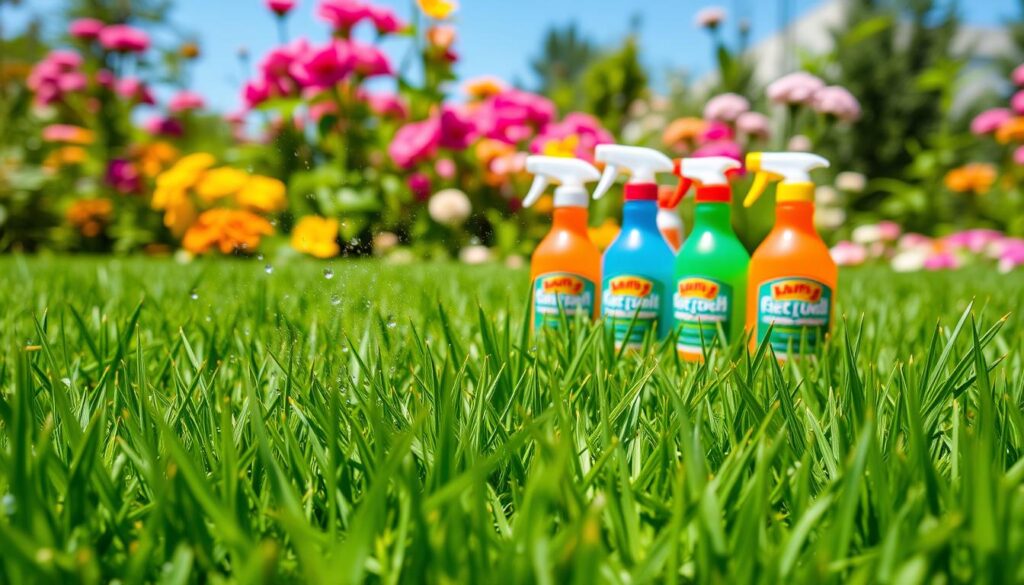
Spring Lawn Care: Aeration and Drainage
When the weather gets warmer, your lawn needs more than just fertilizer to grow well. Spring is the best time for aeration and drainage improvement. These steps can make your grass healthier and look better.
Aeration helps by making holes in the soil. This lets air, water, and nutrients get to the roots. It’s especially good for cool-season grasses in early spring. Warm-season grasses do better with aeration in late spring.
If your lawn was soggy or had poor drainage in winter, fix it in spring. You can add soil amendments or install drainage systems. Good drainage stops soil from getting too hard, keeps weeds away, and helps your grass grow strong.
A healthy lawn needs a mix of complementary lawn care practices. By doing spring lawn aeration and lawn drainage improvement, your lawn can be lush and vibrant all season.
Safety Considerations
When it comes to lawn fertilizers, safety is key. Organic options like Milorganite might seem safer. But, they can still have trace amounts of harmful materials. These can harm pets, kids, neighbors, and the environment.
It’s important to pick lawn fertilizers carefully. They should not harm the environment. Synthetic fertilizers can also pollute water and upset the natural balance if not used right.
To keep your lawn safe and green, follow these tips:
- Choose slow-release, organic fertilizers. They release nutrients slowly, reducing runoff.
- Don’t apply fertilizers before heavy rain or in the hottest part of the day. This can lead to chemical runoff.
- Follow the manufacturer’s instructions for application rates and timing. This helps reduce environmental harm.
- Get your soil tested to know exactly what nutrients your lawn needs. This prevents over-fertilizing.
- Use natural lawn care methods like proper mowing, aerating, and overseeding. These keep your lawn healthy without too many chemicals.
By focusing on safety and sustainability, you can have a beautiful lawn. You’ll also reduce the environmental impact of your lawn fertilizers.
| Fertilizer Type | Coverage Area | Key Benefits |
|---|---|---|
| Milorganite Slow Release Nitrogen Lawn Fertilizer | 2,500 square feet per 32 lb bag | Organic, slow-release formula that promotes gradual, sustainable lawn growth |
| Scotts Turf Builder Starter Food for New Grass | 5,000 square feet | Grows grass 70% thicker and 35% faster for a lush, vibrant lawn |
| Scotts Turf Builder Weed and Feed | N/A | Addresses over 50 common weeds while providing essential lawn nutrients |
| Ironite Mineral Supplement | N/A | Promotes a more vibrant green grass look and reduces the need for frequent mowing |
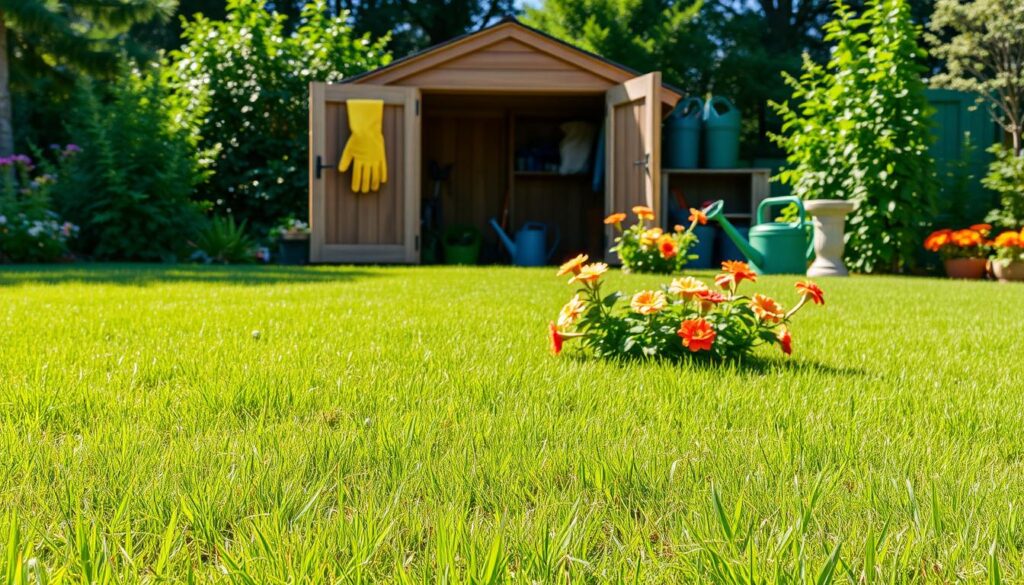
Understanding the risks of lawn fertilizers helps you make better choices. You can protect your lawn, family, and the environment.
Conclusion
Choosing the right spring lawn fertilizer is key to a healthy lawn. Testing your soil and picking the right fertilizer for your lawn are important steps. This will help your grass grow lush and green.
Don’t forget about other lawn care like aeration and drainage. These practices work together with fertilizer to make your lawn look its best.
When picking a fertilizer, consider your climate and grass type. Apply it when the soil is just right. Make sure to water well to help the nutrients soak in.
By following these tips, your lawn will stay healthy and look great all spring and summer. A well-fertilized lawn is not just pretty. It’s also strong and resilient.
Investing in your lawn’s health in the spring pays off in the long run. With the right fertilizer and care, you can have the green lawn you’ve always wanted. Enjoy your beautiful outdoor space all season long.
FAQ
What is the best time to fertilize my lawn in the spring?
Start fertilizing your lawn when the soil temperature hits about 55ºF. Make sure the ground is thawed before applying any fertilizer. In most of the U.S., this is around mid-April. But, check based on your grass type and location.
How do I know if my lawn needs fertilizer in the spring?
Test your soil’s nutrient and pH levels to pick the right fertilizer. Look for signs like new grass growth or flowers blooming. This means it’s time to fertilize.
What are the key nutrients my lawn needs in the spring?
Your grass needs nitrogen (N), phosphorus (P), and potassium (K). Keep your soil’s pH between six and seven for the best growth. If it’s too acidic or alkaline, adjust it with special products.
What are the differences between granular and liquid lawn fertilizers?
Granular fertilizers are easy to store and apply, releasing nutrients slowly. Liquid fertilizers need more care but work fast and evenly. They show results in three days, while granular takes five to seven.
What are some top recommended spring lawn fertilizers?
Stress 12-0-24 from Lebanon Turf, Humic Max 16-0-8 from Country Club, and Complete 14-7-14 from Lebanon Turf are top picks. They offer the right mix of nutrients for spring growth.
What other lawn care practices should I focus on in the spring?
Core aeration is key to better nutrient and water flow. If your lawn is muddy or waterlogged, fix the drainage issues.
Are organic lawn fertilizers a safer choice?
Organic fertilizers like Milorganite are safer, but they can still harm the environment. Always choose wisely and consider their impact.

